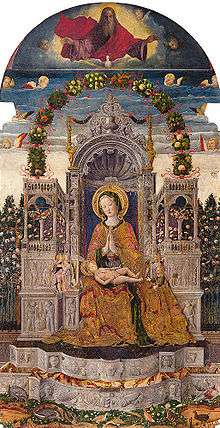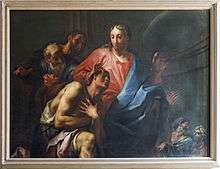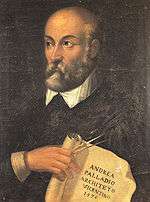San Francesco della Vigna

San Francesco della Vigna is a Roman Catholic church in the Sestiere of Castello in Venice, northern Italy.
History
Along with Santa Maria Gloriosa dei Frari, this is one of two Franciscan churches in Venice. The site, originally a vineyard (Vigna), was donated by Marco Ziani in 1253 for construction of the monastery. A tiny chapel already on the site recalled the spot where an angel supposedly had pronounced Pax tibi Evangelista meus to the shipwrecked apostle St. Mark, patron of Venice.
The first church at the site was a triple-nave Gothic church by Marino da Pisa. A monastery housed the Frati Minori dell'Osservanza, while the Conventuali occupied the Frari across town. By the 16th century, the church building was in need of repair. Two main impulses led to the reconstruction of this church; one was the reform sweeping the order of the Franciscan Observants, and the other was the wishes of Doge Andrea Gritti, whose family palace neighbored the church. In 1534, this Doge laid the foundation stone for the new church. The nave was roofed over by 1554.
Exterior
.jpg)
The church was designed in sober Renaissance style by Jacopo Sansovino in 1554, with the advice of the Franciscan friar, Fra Francesco Zorzi. Fra Zorzi based the sizing of the various elements on the number three, because of its association with the Trinity: the nave should be nine paces wide and 27 paces long, each side chapel three paces wide. However the white marble façade (1564-1570) was not based on Sansovino's designs, but instead was a product of a Andrea Palladio. It is thought that the patrician Daniele Barbaro lobbied for the commission to be switched from Sansovino to Palladio in 1562, convincing the then Patriarch, Giovanni Grimani.
Palladio addressed the challenge of linking the central nave with the side aisles in the façade in an innovative manner. The Corinthian columns in both the center and the sides are perched on the same high plinth, though the central four columns are taller and wider than the lateral ones. The lateral columns support half-pediments that mimic the angle of the central full pediment. Above the central portal is a hemicircular window, interrupted superiorly by a bracket and subdivided into three parts. The façade contains two large bronze statues of Moses and Saint Paul (1592), actively stepping forward from their shallow niches, sculpted by Tiziano Aspetti.
At the top of the tympanum, an eagle unfolds a banner stating Renovabitur. Below, a freize dedication of the church states: Deo utriusque templi aedificatori ac reparatori (God, builder and restorer of both temples) is engraved. Four marble plaques state: Ac cede ad hoc / ne deseras spirituale / non sine iugi exteriori / interiorique bello (Enter here / not abandoning the spirit / not without detaching yourself from the exterior world / and making your interior beautiful).[1]
Inside the church, each chapel was sold for 200-350 ducats to aristocratic donors, raising much needed construction funds, granting the rights to place their coat-of-arms in the chapel and to bury their family there. For the right to be buried in the floor of the chancel in front of the high altar, Doge Andrea Gritti paid 1000 ducats. In 1542, Vettor Grimani and his brother Cardinal Marino acquired rights to build the facade for the church. The three sarcophagi for two cardinals and a patriarch from the Grimani family are no longer in place. The facade of the church was ultimately commissioned from Andrea Palladio (1562) by Giovanni Grimani.
In the 1950s were cast the 5 bells in B rung with the Veronese bellringing art.
Interior

The interior of the church has a simplicity and severity befitting a Franciscan church, with plain Istrian stone Doric pilasters. The choir, which in the past was occupied by the monks during services, is behind the altar. The interior contains an alabaster sculpture of St. Louis of Toulouse and an early 15th-century Gothic painting of the Madonna of humility.
The Grimani chapel (first in the left aisle) is decorated with ceiling paintings by Battista Franco, and murals and altarpiece by Federico Zuccari. The chapel has been restored by the British charity Venice in Peril, which also restored Palladio's facade in the 1990s.[2]
The chapels of the church house masterpieces that both were made for this church or were moved here mainly in the 19th century from shuttering churches, oratories, and monasteries. They belong to some of the most prominent aristocratic families in Venice. Among the chapels, and works therein, are the following (starting from the entrance):[3][4]
Right
- 1st, Bragadin or of St Catherine of Alexandria: The chapel contains an altarpiece depicting Saints Bernardino of Siena, Jerome, and Ludovico by Antonio Vivarini.
- 2nd, Badoer-Surian or of the Immaculate Conception: The chapel was dedicated in 1535 to the Virgin by Piero Badoer, Procurator of San Marco. It also contains the tombs (1563) of Surian family. The chapel has four flanking 18th-century canvases, originally from the Oratory of the Stimmate, depicting on the right the Sacrifice of Isaac by Pittoni and Rebecca at the Well with Eleazar by Nicola Grassi; and on the left, the Samaritan at the Well by Francesco Polazzo and the Healing the Congenitally Blind by Angelo Trevisani.
- 3rd Contarini dalla Porta: The chapel contains an alabaster statue of St Louis of Toulouse, and a canvas by Palma Giovane depicting the Virgin with Saints(1628). The ceiling (completed 1789) depicts the Scenes of Life and Death of St Peter of Alcantara including the Saint on the City Walls, St Theresa of Avila, St Peter, and Queen Isabel of Spain, the Death of the Saint, and Glory of the Saint, all by Francesco Fontebasso. In the walls are allegorical depictions of Faith, Hope, and Charity (right) by Jacopo Marieschi; and Religion and Meditation (left) by Francesco Maggiotto.[5]
- 4th Malipiero Badoer: The chapel contains an altarpiece depicting The Resurrection (1584) by Paolo Veronese.
- 5th Barbaro: The chapel has the heraldic shield of the Barbaro family, a red circle on a white background, granted to admiral Marco Barbaro after his 12th-century victory in Jaffa.[6]
- The right transept has an altar for the Morosini di Sbarra family with the Enthroned Madonna and child (c. 1478) by Antonio da Negroponte. A lunette was added to the painting later, depicting God the Father and the Holy Ghost (early 16th century) by Benedetto Rusconi (il Diana). The transept has a side portal called the Holy Land portal with a Monument to Domenico Trevisan.
- The chancel has a Monument to Andrea Gritti designed by Scamozzi.
- The 18th-century organ was built by Pietro Nacchini.
Left
- 1st left, Grimani: The chapel has an altarpiece depicting the Adoration of the Magi (1561-1564) by Federico Zuccari. The ceiling was frescoed by Giovanni Battista Franco (il Semolei).
- 2nd left, Montefeltro or of St Anthony Abbot: The chapel houses three statues by Alessandro Vittoria.
- 3rd left, Sagredo: The chapel was designed by Tommaso Temanza. It is dedicated to Saint Gherardo Sagredo, an ancestor who died in 1046, and was declared blessed in 1076. The pendedentives depict the four evangelists and four virtues by Tiepolo. The cupola has a fresco painted sotto in su by Pellegrini. The chapel has statue of the Blessed Gherardo by Andrea Cominelli, and other sculptures by Justus Le Court and Enrico Merengo. On the walls are two funeral monuments with busts to the Doges Nicolò Sagredo (ruled 1675-76) and Giovanni Sagredo (ruled 1676-91), with busts by Giovanni Gai. The chapel underscores the complex machinations in an oligarchic and aristocratic Venice to uphold the family name.[7]
.jpg)
_Soffittos_affrescato.jpg) Cupola frescoes by Pellegrino
Cupola frescoes by Pellegrino_Tiepolo_.jpg) Pendentive by Tiepolo
Pendentive by Tiepolo
- 4th left Dandolo: The chapel has a painting of San Bernardo da Siena and works by Giuseppe Porta.
- 5th left Giustinian or "della Salute": The chapel has a canvas by Paolo Veronese, depicting Holy Family with St Catherine and Anthony Abbot (circa 1560). One source places the Veronese Resurrection in this chapel.
- 6th left Priuli: The chapel is dedicated to St Pasquale Baylon depicted in a wooden statue (1691) by Marchiò Molziner.
- Left of apse choir, Giustiniani-Badoer: The chapel was built in 1533-1534, and has sculpted panels by Giovanni Battista Bregno and by Tullio and Antonio Lombardo. It houses the Tomb of Doge Gritti.
- Enter through Left transept, Santa Capella: now houses an altarpiece depicting Enthroned Madonna and Saints (1507) by Giovanni Bellini.
_di_Veronese.jpg)
Notes
- ↑ St. Bernardino Institute of Ecumenical Studies website, entry on church.
- ↑ "Venice in Peril website". Retrieved May 29, 2012.
- ↑ The Rizzoli Art Guides, text by Antonio Manno, Photographs by Massimo Venchierutti and Piero Codato, 2014.
- ↑ Consulting entries in Spanish and French Wikipedia.
- ↑ SaveVenice entry.
- ↑ The Rough Guide to Venice & the Veneto, Jonathan Buckley, Rough Guides, 2004, pg.165
- ↑ W. Barcham.
Sources
- Howard, Deborah (1975). Yale University press, ed. Jacopo Sansovino; Architecture and Patronage in Renaissance Venice. pp. 64–74.
- SaveVenice entry
- Drawing by Canaletto from 1735-40.
- "The Cappella Sagredo in San Francesco della Vigna", by William L. Barcham. Artibus et Historiae (1983). Volume 4(7): 101-124.
External links
| Wikimedia Commons has media related to San Francesco della Vigna (Venice). |
- Campo San Francesco della Vigna, Venice.jc-r.net
Coordinates: 45°26′17″N 12°20′55″E / 45.4381°N 12.3486°E
.jpg)
_par_Giambattista_Pittoni.jpg)



